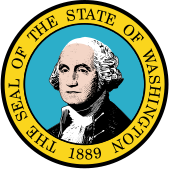Washington Senate
| Washington State Senate | |
|---|---|
| Washington State Legislature | |
 |
|
| Type | |
| Type | |
|
Term limits
|
None |
| History | |
|
New session started
|
January 9, 2017 |
| Leadership | |
|
President Pro Tem of the Senate
|
|
|
Majority Leader
|
|
|
Minority Leader
|
|
| Structure | |
| Seats | 49 |
 |
|
|
Political groups
|
Governing coalition (MCC)
Opposition party
|
|
Length of term
|
4 years |
| Authority | Article II, Washington State Constitution |
| Salary | $42,106/year + per diem |
| Elections | |
|
Last election
|
November 8, 2016 (25 seats) |
|
Next election
|
November 6, 2018 (24 seats) |
| Redistricting | Washington State Redistricting Commission |
| Meeting place | |
 |
|
| State Senate Chamber Washington State Capitol Olympia, Washington |
|
| Website | |
| Washington State Senate | |
Governing coalition (MCC)
Opposition party
The Washington State Senate is the upper house of the Washington State Legislature. The body consists of 49 members, each representing a district with a population of nearly 140,000. The State Senate meets at the Legislative Building in Olympia.
As with the lower House of Representatives, state senators serve without term limits, though senators serve four-year terms. Senators are elected from the same legislative districts as House members, with each district electing two representatives but only one senator.
Like other upper houses of state and territorial legislatures and the federal U.S. Senate, the state senate can confirm or reject gubernatorial appointments to the state cabinet, commissions and boards.
The Lieutenant Governor of Washington serves as the President of the Senate, but only casts a vote if required to break a tie. In his or her absence, the President Pro Tempore presides over the Senate. The President Pro Tempore is elected by the majority party caucus followed by confirmation of the entire Senate through a Senate Resolution. The President Pro Tempore is the chief leadership position in the Senate. The other Senate leaders, such as the majority and minority leaders are elected by their respective party caucuses.
...
Wikipedia
